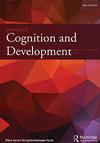求助PDF
{"title":"Can Preschoolers Recognize the Facial Expressions of People Wearing Masks and Sunglasses? Effects of Adding Voice Information","authors":"Fumikazu Furumi, Minori Fukazawa, Yumiko Nishio","doi":"10.1080/15248372.2023.2207665","DOIUrl":null,"url":null,"abstract":"Early childhood is marked by significant developmental changes in the ability to recognize facial expressions. However, since the COVID-19 outbreak, people have been wearing masks more frequently during social interactions which may hamper the recognition of facial expressions. This study examines whether preschoolers recognize the facial expressions of people with partially covered faces (wearing masks or sunglasses) or uncovered faces better, and whether recognition improves when additional voice information is provided. The participants included 27 Japanese preschoolers (11 boys and 16 girls) aged 3-5 years. The participants were presented with two groups of facial expressions: stimuli showing uncovered faces and those showing faces partially covered with a mask or sunglasses. A two-factor within-participant analysis of variance was conducted on the number of correct facial-expression responses in each trial. The children recognized the expressions of uncovered faces significantly better than those of faces with masks or sunglasses. When voice information was added, they recognized all facial expressions. Therefore, partially covered faces interfere with preschoolers' recognition of facial expressions, and voice information aids facial expression recognition.Copyright © 2023 The Author(s). Published with license by Taylor & Francis Group, LLC.","PeriodicalId":47680,"journal":{"name":"Journal of Cognition and Development","volume":" ","pages":""},"PeriodicalIF":1.6000,"publicationDate":"2023-05-04","publicationTypes":"Journal Article","fieldsOfStudy":null,"isOpenAccess":false,"openAccessPdf":"","citationCount":"0","resultStr":null,"platform":"Semanticscholar","paperid":null,"PeriodicalName":"Journal of Cognition and Development","FirstCategoryId":"102","ListUrlMain":"https://doi.org/10.1080/15248372.2023.2207665","RegionNum":2,"RegionCategory":"心理学","ArticlePicture":[],"TitleCN":null,"AbstractTextCN":null,"PMCID":null,"EPubDate":"","PubModel":"","JCR":"Q3","JCRName":"PSYCHOLOGY, DEVELOPMENTAL","Score":null,"Total":0}
引用次数: 0
引用
批量引用
学龄前儿童能识别戴口罩和太阳镜的人的面部表情吗?添加语音信息的效果
儿童早期识别面部表情的能力发生了显著的发育变化。然而,自新冠肺炎爆发以来,人们在社交活动中戴口罩的频率越来越高,这可能会阻碍面部表情的识别。这项研究考察了学龄前儿童是否能更好地识别面部部分遮盖(戴口罩或太阳镜)或未遮盖的人的面部表情,以及当提供额外的语音信息时,识别能力是否会提高。参与者包括27名3-5岁的日本学龄前儿童(11名男孩和16名女孩)。参与者被呈现出两组面部表情:显示未遮盖面部的刺激和显示面部部分被口罩或太阳镜覆盖的刺激。在每个试验中,对正确的面部表情反应的数量进行了双因素内参与者方差分析。孩子们对未戴口罩的脸的表情识别能力明显优于戴口罩或太阳镜的脸。当添加语音信息时,他们可以识别所有的面部表情。因此,部分覆盖的人脸会干扰学龄前儿童对面部表情的识别,而语音信息有助于面部表情识别。版权所有©2023作者。由Taylor&Francis Group,LLC授权出版。
本文章由计算机程序翻译,如有差异,请以英文原文为准。


